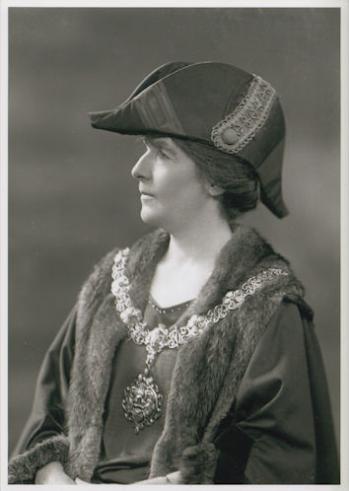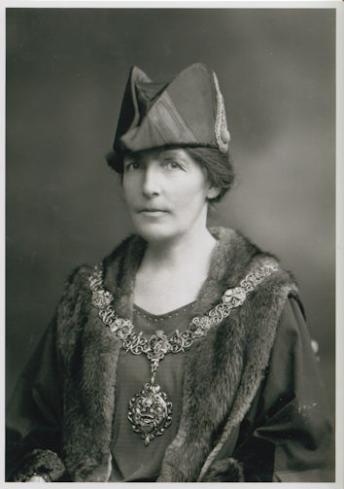Eva Hartree was a Cambridge Borough Councillor from 1921-27 and 1929-43 and the first Lady Mayor of Cambridge in 1924-25. See also Eva Hartree’s Life and Times.


Eva Rayner (1873-1947) was born in Stockport on 24 December 1873. Her grandfather had a year as Mayor of Stockport. Her father was one of the leading doctors in Stockport, with his work including being a supervising surgeon in local factories. Eva accompanied him on some of his visits, gaining an insight into factory work and conditions. She came to Girton College in 1892 to read Natural History, completing the Tripos examination in 1895 and marrying William Hartree in the same year. William Hartree was a lecturer in engineering at Cambridge. Eva and William Hartree had 6 children, only 2 of whom survived beyond infancy and another died in 1914, possibly from meningitis.
The family lived in Newton Road from 1907-13, when Eva was involved with the British Red Cross Society, where she organised and ran first aid and nursing classes and was Commandant of the Trumpington Voluntary Aid Detachment (VAD). They moved from Cambridge in 1913, living in Farnham for a short period where she became secretary of the Farnham Suffrage Society, then Falmouth, then Guildford where she became more involved in public duties, including the Women’s Suffrage Society. William Hartree worked for the Anti-Aircraft Experimental Section of the Ministry of Munitions during World War 1, assisting in the development of better defences against air raids. The family returned to Cambridge in 1919 and lived in Newton Road and then Bentley Road.
In 1921, Eva Hartree contested the Cambridge Without Ward and was elected to the Borough Council. She served as a Cambridge Borough Councillor for twenty years from 1921-27 and 1929-43 and was the first Lady Mayor of Cambridge in 1924-25. She had terms as a member of all the major committees of the Corporation, with a particular interest in the Public Health, Maternity and Child Welfare and the Library Committees. In an article in 1930, she was described as having tremendous driving force and energy hidden beneath her outwardly fragile appearance. She had Graves’ disease from 1914 and had to retire from public life for three years after her term as mayor, before continuing as councillor.
Eva Hartree was very active in feminist and humanitarian causes, campaigning against the regulations which barred women from some employment when they married. She had terms as Secretary of the Cambridge League of Nations, as a District Commissioner of the Girl Guides and as Chairman of the Cambridge Spanish Aid Committee, which organised homes for political refugees from the Spanish Civil War. She was also a Member of the Executive Committee of the British National Council of Women (and President for one period).
William Hartree died in April 1943. Eva Hartree moved to London after her husband died, where she continued to work with refugees. She died at the Evelyn Nursing Home in Trumpington in September 1947. An appreciation in her obituary ends with “this great and ancient Borough of Cambridge must always be proud that its first woman Mayor was of such outstanding ability and of such greatness of humanity”.
Their surviving son, Douglas Rayner Hartree (1897-1958), became an eminent mathematician and physicist. He was influential in the development of early electronic computers and was appointed the Plummer Professor of Mathematical Physics at the University of Cambridge in 1946. Douglas and Elaine Hartree lived in Barrow Road and Bentley Road in the 1920s and again in the 1940s-50s. The Hartree Centre based at the Daresbury Laboratory, Cheshire, is named after him and is supporting industry in the development of high performance computing, big data and cognitive technologies.
In March 2019, the main hall in the Clay Farm Centre was named the Eva Hartree Hall.
Sources
Sue Edwards (2007). Chronology of the Mayors of Cambridge, 1835-2007. Cambridge: City Council. [Cambridgeshire Collection, Cambridge Central Library.]
Marie Thompson (1996). An Inspiring Generation: ‘New Woman’ of Cambridge, 1900-1930 . MA Dissertation, Ruskin College, Oxford. [Cambridgeshire Collection, Cambridge Central Library.]
Report on election of Mayor, Cambridge Chronicle, 5 and 12 November 1924, p. 6 and p. 9.
Cambridge Chronicle, 6 November 1929, p. 3.
First Lady Mayor, Independent Press and Chronicle, 14 November 1924, p. 10.
Pen Pictures of Women Workers: Councillor Mrs Hartree, Cambridge Independent Press, 14 February 1930
Ex-Mayor’s Bereavement. Death of Mr W. Hartree. Cambridge Independent Press and Chronicle, 30 April 1943, p. 13.
Death of Cambridge’s First Woman Mayor, Cambridge Daily News, 10 September 1947, p. 7.
Douglas Hartree:
Wikipedia entry.
Hartree Centre.
People in Trumpington records:
William Hartree, Eva Hartree.
Douglas Rayner Hartree.